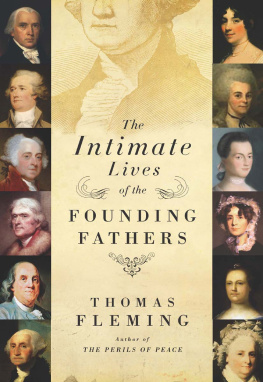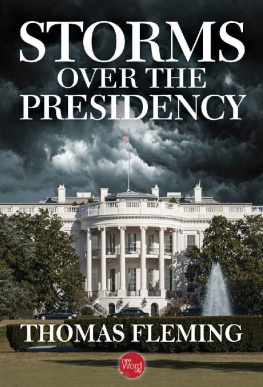On April 16, 1849, a chilly Sunday morning in Washington, D.C., household after household reported the shocking news that their slaves were nowhere to be found. Fires were left unstoked, breakfasts uncooked, beds unmade. Federal marshals soon had reports of forty-one runaways, and by noon they concluded that no less than seventy-six men, women, and children - nearly 3 percent of the districts 3,687 slaves had headed for parts unknown.
The city reeled with disbelief. For more than a decade, North and South had been quarreling over slavery. Abolitionists called for the immediate emancipation of the Souths 4 million slaves. Moralists maintained a steady attack on the peculiar institution of slavery in their network of newspapers. In precarious alliance with the abolitionists were the new president Zachary Taylor and the Free Soil politicians who wanted to confine slavery to the fifteen states in which it was legal.
The dispute had become virulent in the aftermath of the American-Mexican War , which had added 900,000 square miles to the national domain. Northerners backed a resolution to ban slavery from the newly acquired territories as Southerners objected, defending slavery as an economic system good for both blacks and whites. They maintained that most slaves were content with their lot and that those who fled north to freedom on the Underground Railroad were seduced by abolitionist propaganda.
The flight of seventy-six Washington slaves was a stunning refutation of this argument. These were household servants who had never picked a boll of Mississippi cotton in the broiling sun. They lived in comfortable quarters, wore warm clothing, and ate decent food. Their exodus suggested there was something intrinsically wrong with the idea of slavery - something no amount of good treatment could ameliorate. Congressmen opposed to slavery, such as the representative from Illinois, Abraham Lincoln , would certainly suggest as much to their Southern colleagues.
Furious slave owners called for a posse. Soon a hundred well-armed men stood outside the federal marshals headquarters. They galloped into Maryland, the logical direction the fugitives would take, and returned empty-handed. No one who lived on or near the roads out of the capital had seen a large group of African-American runaways.
Stymied, the marshals began to interrogate blacks who had come to their attention in the past. The District of Columbias 10,059 free African Americans had staged several violent protests against the continued presence of slave traders in their midst. More than once the traders had kidnapped free blacks and smuggled them out of the city to sell for large profits in Georgia or Louisiana.
The frantic marshals got nowhere until they encountered Judson Diggs, a black hackman, who told them that all the runaways had sailed from White House Wharf on the Potomac the previous night aboard a schooner named Pearl.
Why did Diggs reveal this information? According to some, he was angry because one of the runaways, Mary Edmondson, had refused his romantic entreaties. Another version had him brooding because a fugitive he carried to the wharf in his hack failed to give him a good tip. In fact, Diggs may have simply been trying to curry favor with the police, assuming the fugitives were safely out of their reach.
If so, Diggs badly underestimated the technology available to the slave owners. One wealthy Georgetown family that lost three slaves volunteered their steam yacht Salem to the authorities, and before nightfall thirty-five members of the posse were churning down the Potomac in pursuit of ThePearl.
Where had this mystery ship come from? Who was in command?
Captain Daniel Drayton has been largely forgotten by all but a few historians specializing in the field of slavery. Not quite a hero, neither was he a knave. Born on the banks of the Delaware River in South Jersey, Drayton, then forty-seven, had spent his life in the coastal-shipping business. His luck on the high seas was no luck; he lost two ships in storms and went bankrupt.
In 1847, while running a hired boat up and down Chesapeake Bay, Drayton transported a family of seven blacks to freedom - and presumably was paid for his trouble. On the southern end of the Underground Railroad, cash was vital. The reason was brutally simple: People could be put in jail for a long time for helping slaves escape. Only when blacks reached free states where there was little fear of punishment did idealism motivate many whites.
In Baltimore the following year, Drayton met Paul Jennings, the black servant of Senator Daniel Webster of Massachusetts. Jennings had been the slave of President James Madison , but technically, he was now a free man; Webster bought him on a visit south and freed him after Jennings agreed to work off his purchase price at the rate of $8 a month in addition to his room, board, and clothing. Jennings still had several hundred dollars to go and decided to make his freedom genuine by going north.
Well educated - at Websters order, the tall, dignified black man was often admitted to the Senate gallery to hear the senator speak - Jennings had a larger motive that justified his course. He was also negotiating for several friends who wanted to escape the slave system that permeated the nations capital and surrounding countryside.
Carpenter Daniel Bell was himself a free man, and his wife and eight children had been freed on their masters deathbed. But the masters heirs were contesting his will, claiming the dying man had not known what he was doing, and Bell was running short of money to fight them in court. He feared the will would be set aside and the heirs would sell his family to local slave traders, who would almost certainly ship them south.
Thomas Ducket was enslaved in Maryland, but his wife and two children were in bondage in Washington. He wanted to get them out of the capital and planned to head north on his own as soon as he learned they had escaped.
Samuel Edmondson, a butler in a wealthy Washington home, had been trying to buy his freedom for years, but the price his owners had set was so high that he doubted he would ever achieve it. He, too, had decided to head north, and he persuaded his brother. Richard, and his two sisters, sixteen-year-old Mary and fourteen-year-old Emily, also still enslaved, to join him. Their father, Paul, was free; their mother, Mary, was a slave, whose owner permitted her to live in a cottage outside Washington and have a family. By the peculiar legal logic of the system, all of Mary Edmondsons children remained slaves; her owner made a nice income selling their services to local families.
Paul Jennings struck a bargain with Drayton, who admitted that the low state of my pecuniary affairs did not allow me to decline. Drayton offered Stephen Sayres, owner of ThePearl, $100 as his share of the profits and urged Jennings to gather as many runaways as possible. It is likely that Drayton contacted abolitionists, who saw the propaganda value and may have agreed to finance a large getaway at the going rate of $15 a slave.
After the fact, Drayton said he had never attended an abolition lecture in his life, but his work as a Chesapeake Bay sailor had put him in touch with many slaves, and he sympathized with their plight. I found out they had the same desires, wishes, hopes as myself, he said. Cash, he insisted, was not his only motive for accepting the job: I undertook it out of sympathy for the enslaved, and from my desire to do something for the cause of universal liberty.
Jennings recruiting for ThePearl received unexpected assistance. On April 13, 1849, just as the ship was tying up at White House Wharf, news reached the capital that French revolutionists had overthrown King Louis-Philippe and declared a republic. Washingtons politicians celebrated as if the United States were responsible. Among the speakers in Lafayette Square opposite the White House was Senator Henry Foote of Mississippi, who declared the age of tyrants and slavery was drawing to a close. Slave-owner Foote predicted a coming era when the whole family of man would enjoy universal emancipation. Not a few enslaved African Americans decided to take the senator at his word and signed aboard
Next page












